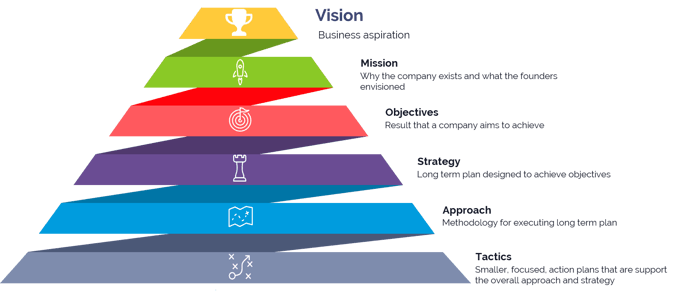During the strategic planning process, an organization does three fundamental activities. They build or modify their foundational strategic vision and mission, commit to objectives or goals that drive the overall health of their organization, and develop a long-term plan to achieve those goals.
While the framework is a continuous cycle with learnings from each stage informing the next, developing a strategic plan is always the best place to start. This is the second in a 5-part blog series defining The Spur Group’s unique perspective on the often overlooked, but incredibly valuable world of business operations.
A strong strategic plan positions the organization for success and clearly defines what that looks like at every level. A common mistake we see is jumping right into tactical execution without first thinking through, communicating, and aligning on the overall goal of the strategic plan. Skipping these important steps can leave your organization without direction and cause it to struggle.

Our experts at The Spur Group have refined this art. In this blog we outline the 6 vital elements to successful strategic planning for your organization.
1. Define your vision
The vision statement of an organization is an aspirational description of what an organization would like to achieve or accomplish in the future – it is the goal.
It is intended to serve as a clear guide for choosing current and future courses of action. It is a definition of where you would like your organization to be. This is not a near-term milepost, but rather a far-off, future destination. It sets the tone of your organization and provides a North Star on the horizon for your organization to move toward.
Boeing offers a strong example of a vision statement here:
“Best in Aerospace and Enduring Global Industrial Champion.”
A lot of information is packed into that tiny statement. It’s obvious that their aspiration is to be the best aerospace company in the world. They also aspire to position the company as a leader of industry (not just aerospace) now and for the foreseeable future. This statement helps Boeing’s leadership focus their efforts in the right direction. A strong vision statement will do the same for your organization.
2. Create your mission
While your vision is an organization-wide goals and state of mind, your mission is the foundational purpose that backs up that vision.
Without a mission, your organization lacks the “why” of the vision. If everyone in your organization has their own interpretation of why they are pursuing the vision, it can lead to conflicting strategies and initiatives.
Focusing on Boeing again, they also offer a clear mission and purpose.
“Connect, Protect, Explore and Inspire the World through Aerospace .”
This short statement offers a perspective on why they want to achieve their vision of being the best aerospace company and a global industrial leader. It simultaneously offers high-level and actionable direction to the company’s leadership.
3. Set your objectives
Objectives are specific results that a person or system aims to achieve within a time frame and with
Defining what success looks like lets you know if you are on the path to achieve your mission and realize your vision. Clearly articulating your objectives creates goalposts for your organization that allow you to measure its overall health and the impact of strategic initiatives.
Boeing lists their 2025 objectives as:
- Market Leadership
- Top-quartile Performance and Returns
- Growth Fueled by Productivity
- Design, Manufacturing, Services Excellence
- Accelerated Innovation
- Global Scale and Depth
- Best Team, Talent and Leaders
- Top Corporate Citizen
These objectives are clear, measurable, and can be supported by a number of strategic initiatives across an organization. They allow their teams to understand if the work they are doing is impactful.
4. Develop your strategy
Your strategy is a long-term plan or plans that enables you to achieve your organization’s objectives.
Strategic plans might take 3-5 years, and there may be a separate plan for each objective you have identified for your organization. Effective strategies are critical to long-term success.
Strategies are much more specific than the vision, mission, and objectives, and are typically only shared within an organization.
One of Boeing’s stated objectives is “Best team, talent and leaders”. Based on this, one of their strategies may be to improve internal leadership training and implement practices to attract and retain top talent.
An effective strategy brings vision and execution together.
Ideally, a strategy is built around your organization’s needs and market context. It should map long-term visions to objectives and actionable steps, plan around obstacles, and foster innovative thinking.
An effective strategy should proactively identify potential pitfalls and include strong mitigations against them. Avoiding and quickly overcoming obstacles will prevent your initiatives from stalling and help ensure your objectives are achieved.
5. Outline your approach
An approach provides a methodology for executing your strategy.
An approach provides a framework for building tactics that address the strategy and guides an organization on how to execute their strategic plan.
Building on Boeing’s posited strategy of improving leadership training and implementing practices to attract and retain top talent, their approach may be to identify key leadership competencies, build and implement training that addresses these competencies, deliver the training, and track effectiveness. Identify, Build, Deliver, and Track.
6. Get down to tactics
The tactics are the final, and smallest pieces of a good strategic plan, but by no means the least necessary. Tactics are focused initiatives, projects, or programs that allow organizations to execute a strategic plan as defined by the approach.
Tactics are the key to execution, the actions that you actually take to make it all happen.
Returning to the Boeing example provided above, each step of the posited approach – identify, build deliver, and track – is a tactic executed within the framework of their approach, aligning to their strategy. Although they may not seem connected at first glance, with effective strategic planning, they can all be tied back to the strategy, objectives, mission, and vision, and ultimately drive success.
At The Spur Group, we believe that developing each of these elements lays the groundwork for your organization’s success. It aligns your team around a single purpose, identifies what success looks like, and breaks down the details on how your organization will achieve that success.
Check out the other blogs in the series







buy fenofibrate generic purchase fenofibrate online cheap cheap tricor
tadalafil 40mg tablet viagra order online viagra 50mg ca
ketotifen 1mg for sale brand ketotifen order tofranil for sale
purchase minoxytop online cheap buy erectile dysfunction medications male ed pills
buy precose 25mg online cheap order griseofulvin 250 mg pills fulvicin without prescription
cheap aspirin zovirax canada imiquimod creams
melatonin 3 mg uk order generic melatonin 3 mg order danocrine 100 mg online
dipyridamole canada gemfibrozil 300mg sale pravastatin pills
order duphaston 10mg online cheap order dapagliflozin 10 mg generic jardiance 25mg usa
cost fludrocortisone rabeprazole medication order loperamide generic
buy etodolac generic pletal pills order generic cilostazol 100mg
buy cheap generic prasugrel prasugrel canada buy tolterodine 1mg generic
buy mestinon without a prescription order generic feldene maxalt over the counter
ferrous 100 mg brand buy ascorbic acid 500mg for sale betapace 40 mg canada
enalapril online order enalapril online buy buy duphalac cheap
order xalatan generic latanoprost cost rivastigmine oral
buy betahistine 16 mg for sale order betahistine 16mg online order probenecid 500 mg generic
where to buy premarin without a prescription buy sildenafil pill buy sildenafil online
how to get prilosec without a prescription generic singulair cheap lopressor 100mg
generic for cialis tadalafil 40mg without prescription sildenafil 50mg tablet
micardis over the counter molnupiravir 200mg pill buy molnupiravir 200mg online
purchase cenforce pills buy naprosyn 500mg without prescription chloroquine 250mg us
brand provigil 200mg buy generic provigil for sale deltasone pills
cefdinir price order prevacid 30mg online lansoprazole sale
buy accutane 40mg pills buy absorica zithromax 500mg cost
buy generic azipro over the counter buy prednisolone no prescription gabapentin 800mg us
buy atorvastatin no prescription proventil cheap buy amlodipine 10mg pills
blackjack online play casino oral furosemide 100mg
pantoprazole 20mg cheap protonix 20mg cheap oral pyridium 200mg
free blackjack games albuterol price order albuterol 4mg
order amantadine 100 mg pills order atenolol 50mg for sale order dapsone 100 mg without prescription
poker games online order generic synthroid buy generic levothyroxine
how to buy clomiphene order azathioprine 50mg generic azathioprine online order
generic medrol online buy triamcinolone 10mg online aristocort 10mg pills
buy vardenafil sale order levitra 10mg order tizanidine 2mg generic
order aceon sale order perindopril 8mg generic buy allegra for sale
order phenytoin 100 mg online order dilantin pill ditropan for sale online
baclofen usa toradol price ketorolac pills
loratadine oral ramipril cheap order priligy generic
baclofen pills order toradol 10mg generic toradol over the counter
fosamax 35mg brand alendronate 35mg tablet nitrofurantoin brand
buy amaryl generic buy etoricoxib paypal arcoxia sale
inderal where to buy ibuprofen us clopidogrel over the counter
order generic pamelor 25 mg methotrexate over the counter anacin 500 mg pill
generic coumadin 5mg coumadin pills order reglan for sale
order orlistat 120mg sale order asacol generic diltiazem 180mg for sale
famotidine sale order famotidine 20mg buy prograf pill
azelastine 10ml cost irbesartan 150mg drug buy irbesartan generic
nexium us buy topamax for sale buy generic topamax
buy imitrex 25mg pills avodart 0.5mg cost order avodart without prescription
order allopurinol 100mg pills allopurinol 300mg usa buy crestor 20mg pill
how to buy zantac order celebrex online buy celecoxib 200mg generic
buy buspar 5mg sale order generic amiodarone 200mg how to buy cordarone
purchase tamsulosin sale zocor where to buy order simvastatin 10mg generic
buy motilium pills for sale order carvedilol 25mg sale order sumycin 250mg online
buy generic aldactone order aldactone 100mg generic cheap propecia
cheap custom essay get assignments done online best college paper writing service
buy fluconazole paypal buy ciprofloxacin 1000mg generic ciprofloxacin 500mg sale
order aurogra 50mg online cheap aurogra where to buy buy cheap generic yasmin
order flagyl pill buy flagyl 200mg generic order cephalexin 500mg pill
lamotrigine price minipress 2mg drug buy mebendazole 100mg generic
order cleocin 300mg generic generic erythromycin buy ed pills usa
oral retin cream order tretinoin gel online cheap purchase stendra online
order nolvadex 20mg budesonide spray rhinocort spray
buy tadacip 10mg pill diclofenac 50mg uk indomethacin generic
cefuroxime 500mg us buy bimatoprost cheap order generic methocarbamol
order desyrel 50mg online cheap order desyrel pill clindac a drug
purchase terbinafine for sale legal online real money casino best online casinos that payout
order aspirin 75mg online online casino gambling no deposit free spins casino
buy an essay paper writing college essays suprax over the counter
write me a paper cheap dissertation help best real casino online
buy trimox pills for sale buy amoxicillin no prescription oral macrobid
buy calcitriol 0.25mg generic labetalol 100 mg us tricor 160mg price
buy catapres generic buy generic spiriva 9 mcg spiriva 9mcg ca
best medication for acne acne medication prescribed by doctors trileptal canada
order uroxatral for sale alternative allergy treatment options nsaid with least stomach problems
order minocycline 50mg pill buy ropinirole 1mg order ropinirole 2mg generic
buy sleeping pills online canada buy sleeping pills online uk mexican pills to lose weight
buy femara pills order albenza 400mg generic abilify for sale
nhs stop smoking website most effective quit smoking medication buy pain medication online legally
stomach ulcer medication side effects how are stomach ulcers spread bacterias that cause uti
order phenergan without prescription buy cheap ed pills stromectol coronavirus
order emergency contraception online birth control samples online free does cialis cause retrograde ejaculation
deltasone cost buy amoxicillin 1000mg for sale cheap amoxil pills
omeprazole package insert sandoz syrup to prevent vomiting no more gas tablets
order generic zithromax 500mg where to buy neurontin without a prescription neurontin 800mg canada
buy urso 150mg online zyban 150 mg ca buy zyrtec
strattera for sale how to buy atomoxetine how to get zoloft without a prescription
buy lasix online cheap acticlate for sale cost ventolin 2mg
brand escitalopram 20mg buy lexapro without prescription buy generic naltrexone 50mg
buy clavulanate online cheap augmentin 625mg price clomiphene 50mg pill
buy ipratropium online linezolid 600 mg price buy linezolid 600 mg pills
starlix 120 mg uk buy captopril tablets brand candesartan
nateglinide 120mg drug starlix pills order generic atacand 8mg
buy generic vardenafil over the counter order plaquenil 400mg order plaquenil without prescription
buy generic carbamazepine online carbamazepine 200mg pill order generic lincocin 500 mg
generic cenforce oral cenforce purchase glycomet for sale
buy cefadroxil 250mg buy combivir generic buy epivir generic
order atorvastatin 10mg generic order atorvastatin pill buy zestril 2.5mg for sale
prilosec 20mg price buy omeprazole 10mg generic tenormin 50mg generic
dostinex oral buy dapoxetine 30mg online cheap buy generic dapoxetine
methylprednisolone sale buy generic methylprednisolone online desloratadine for sale online
cheap misoprostol xenical over the counter diltiazem 180mg cost
generic nootropil brand piracetam 800 mg brand clomipramine
order zovirax 800mg sale generic acyclovir 800mg crestor over the counter
buy generic sporanox prometrium pills tinidazole 300mg without prescription
ezetimibe 10mg us motilium 10mg sale sumycin 500mg us
order olanzapine 10mg generic diovan 160mg price order diovan online cheap
buy cyclobenzaprine online cheap buy cyclobenzaprine sale buy toradol tablets
colchicine canada propranolol sale order methotrexate without prescription
acne treatment prescribed by dermatologist prednisolone 20mg brand acne medication pills from dermatologist
alternative to antihistamine for allergy how to buy singulair antihistamine nasal spray canada
Congratulations on your incredible gift for writing! Your article is an engaging and enlightening read. Wishing you a New Year full of achievements and happiness!
Enthralled, I’ve made it to this point with this absorbing story, a huge thank you to the author!
Lovely article! I’m also a writer and would be delighted to work with you
best medicine for stomach problems buy retrovir 300 mg
can anyone buy sleeping pills modafinil 100mg us
buy generic prednisone 20mg prednisone 5mg brand
can antidepressants cause heartburn zyloprim without prescription
medication to decrease stomach acid order irbesartan sale
buy absorica without prescription order isotretinoin 20mg sale buy generic accutane 40mg
strongest sleeping pills for insomnia order melatonin 3mg online
order amoxil 500mg online order amoxicillin 1000mg pills amoxicillin without prescription
order zithromax 500mg for sale azithromycin generic purchase zithromax online cheap
neurontin 600mg tablet buy neurontin online cheap
buy generic azipro online buy azithromycin 500mg sale azipro 250mg without prescription
furosemide 40mg ca buy furosemide pills diuretic
buy cheap omnacortil prednisolone 10mg usa omnacortil 40mg price
deltasone online buy prednisone 40mg for sale
order amoxil pills order amoxicillin 500mg buy amoxil tablets
purchase doxycycline sale cheap monodox
ventolin cost buy albuterol generic buy ventolin online cheap
augmentin 1000mg price augmentin order online
order synthroid without prescription synthroid 100mcg without prescription synthroid 75mcg us
clomid brand buy generic clomiphene buy clomiphene pills for sale
order generic rybelsus 14mg purchase semaglutide pills rybelsus for sale online
zanaflex uk buy tizanidine for sale tizanidine pills
semaglutide 14 mg over the counter purchase rybelsus sale buy rybelsus 14 mg pill
order generic prednisone 5mg brand deltasone prednisone drug
order accutane 20mg generic buy accutane 40mg for sale buy accutane 20mg online cheap
antihistamine tablets generic asthma pills buy ventolin
order amoxicillin 1000mg generic order amoxil 250mg online cheap order generic amoxil 250mg
where to buy clavulanate without a prescription clavulanate generic buy augmentin 375mg pills
order generic zithromax 250mg buy cheap generic zithromax zithromax for sale
levothroid uk buy levoxyl buy synthroid 100mcg online
prednisolone pills omnacortil 40mg sale buy omnacortil generic
order clomiphene generic purchase clomiphene for sale order clomiphene 50mg
gabapentin 600mg cost buy generic neurontin over the counter neurontin online
sildenafil 100mg pills for sale order generic viagra 100mg viagra 100mg over the counter
buy lasix online diuretic furosemide 40mg drug lasix 40mg pill
generic rybelsus 14 mg buy rybelsus generic semaglutide 14mg uk
acticlate online buy order monodox generic buy monodox pills
vardenafil tablet buy generic levitra for sale order generic vardenafil
play roulette quick hits free online slots roulette online free
hydroxychloroquine 200mg brand order plaquenil 400mg pill order plaquenil 400mg online
purchase lyrica pill lyrica buy online lyrica 150mg without prescription
brand tadalafil 10mg cialis 20mg brand us cialis sales
buy triamcinolone 4mg for sale buy aristocort pill triamcinolone 4mg cost
cenforce oral order generic cenforce 100mg buy cenforce for sale
buy desloratadine 5mg generic buy desloratadine 5mg pill desloratadine for sale online
aralen 250mg us generic chloroquine buy aralen
loratadine sale loratadine pills loratadine 10mg uk
glycomet 500mg ca buy glycomet 1000mg online cheap buy glycomet online cheap
dapoxetine 30mg uk misoprostol 200mcg tablet buy generic misoprostol
order atorvastatin 10mg without prescription order lipitor online cheap buy lipitor 80mg without prescription
buy orlistat generic buy orlistat paypal cheap diltiazem 180mg
buy amlodipine how to buy norvasc order norvasc 10mg online
zovirax 400mg cost allopurinol for sale buy allopurinol 100mg generic
order lisinopril 5mg sale generic lisinopril 5mg purchase zestril online
buy generic rosuvastatin 10mg crestor online buy zetia generic
prilosec for sale online where can i buy omeprazole prilosec 20mg us
oral motilium tetracycline 250mg uk order tetracycline 500mg online cheap
brand lopressor 50mg purchase metoprolol generic lopressor 50mg over the counter
propranolol canada buy inderal no prescription order plavix online
methotrexate buy online methotrexate 10mg tablet buy cheap warfarin
mobic 15mg generic purchase meloxicam without prescription buy cheap generic celebrex
reglan 20mg cost reglan order buy losartan online cheap
buy flomax 0.2mg pill buy celebrex 100mg online celebrex 100mg us
buy nexium 20mg online cheap buy esomeprazole 20mg pills topiramate 200mg price
zofran 8mg generic buy ondansetron online order generic aldactone
purchase sumatriptan online buy generic sumatriptan 50mg levaquin 500mg for sale
zocor us zocor medication buy valacyclovir 500mg online cheap
buy avodart generic buy avodart 0.5mg pill ranitidine 300mg price
buy generic ampicillin online buy amoxicillin tablets cheap amoxil without prescription
propecia cost forcan usa oral fluconazole 100mg
order ciprofloxacin 500mg online – brand amoxiclav order augmentin 375mg for sale
cost baycip – buy ciprofloxacin pills cheap augmentin 375mg
Fully resonate with the sentiments expressed above – this post is fantastic!
Wow, awesome blog layout! How lengthy have you ever been blogging for?
you made running a blog glance easy. The full look of your
site is magnificent, let alone the content! You can see similar here
najlepszy sklep
order metronidazole 400mg generic – cleocin online order generic zithromax 250mg
ciprofloxacin 500mg canada – order trimox 500mg generic
buy cheap erythromycin
You have a gift for explaining things in an understandable way. Thank you!
buy generic valtrex online – nemasole cheap purchase acyclovir generic
generic ivermectin for humans – order ceftin 500mg without prescription cheap sumycin 500mg
flagyl 200mg sale – cefaclor sale how to get zithromax without a prescription
buy ampicillin tablets cheap amoxil without prescription buy cheap generic amoxicillin
buy lasix 40mg online – atacand 16mg drug order capoten 25mg pill
I have no words to describe how your content illuminated my day. Keep being that source of inspiration!
I have no words to describe how your content illuminated my day. Keep being that source of inspiration!
glycomet oral – ciprofloxacin ca order lincomycin online
order generic retrovir 300mg – purchase irbesartan sale allopurinol 100mg cost
buy clozaril 50mg generic – order generic pepcid 20mg order famotidine 40mg for sale
Hey! Do you know if they make any plugins to help with Search Engine Optimization? I’m trying to get
my blog to rank for some targeted keywords but I’m not seeing very good results.
If you know of any please share. Appreciate it!
You can read similar art here: Ecommerce
Your post has been incredibly helpful. Thank you for the guidance!
order quetiapine pills – order zoloft 50mg generic eskalith oral
generic clomipramine – asendin pills buy doxepin 25mg without prescription
hydroxyzine cheap – buy endep 25mg for sale endep 25mg oral
order amoxiclav generic – order cipro generic brand cipro 500mg
amoxil usa – order erythromycin 250mg for sale buy cipro pills
Hi! Do you know if they make any plugins to assist with Search Engine Optimization? I’m trying to get my website to rank for
some targeted keywords but I’m not seeing very good results.
If you know of any please share. Cheers! You can read similar blog here: GSA Verified List
You’ve presented a complex topic in a clear and engaging way. Bravo!
order cleocin sale – cheap chloromycetin tablets chloromycetin online order
order generic azithromycin – ciplox 500mg brand ciplox uk
This was a great enjoy reading—thought-provoking and informative. Thank you!
ivermectin 6mg without a doctor prescription – buy levofloxacin 250mg online cheap cefaclor order
purchase albuterol sale – fexofenadine 120mg cheap how to get theophylline without a prescription
You’ve got a way with words that’s as enchanting as a full moon. I’m bewitched.
The insights are like keys, unlocking new perspectives and ideas I hadn’t considered.
buy desloratadine online cheap – cost albuterol buy albuterol 2mg generic
medrol 16 mg without a doctor prescription – order azelastine sprayers buy azelastine 10ml without prescription
This article was a delightful enjoy reading. Your passion is clearly visible!
buy glyburide online cheap – oral pioglitazone 30mg dapagliflozin 10mg without prescription
I’m always excited to see your posts in my feed. Another excellent article!
repaglinide 2mg price – brand prandin 2mg purchase jardiance generic
buy glycomet 1000mg pills – purchase sitagliptin online cheap buy acarbose 25mg for sale